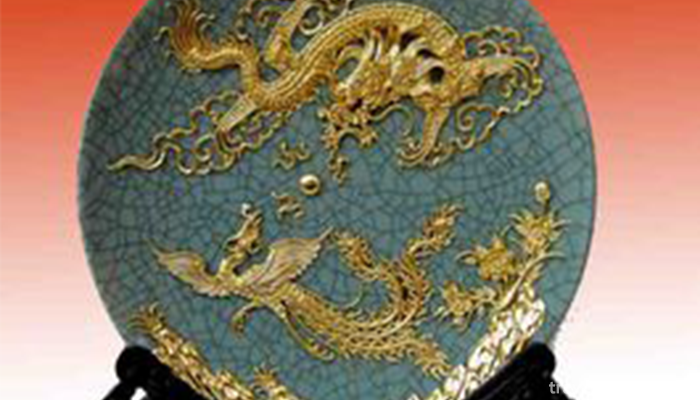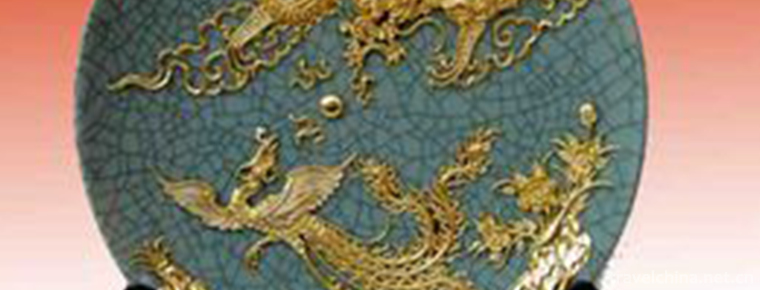Xiamen lacquer line carving skills
Xiamen lacquer line carving skills
Xiamen lacquer line carving technology, local traditional handicraft in Xiamen City, Fujian Province, is one of the national intangible cultural heritage.
Xiamen lacquer line carving technique is to use old brick powder, large paint and cooked tung oil as raw materials to mix, repeatedly beat into soft and resilient clay (commonly known as "lacquer line soil"), then hand-rubbed into a linear "lacquer line", and then on the body coated with primer with "lacquer line" disc, knot, winding, stacking, to shape a convex figure.
On May 20, 2006, Xiamen lacquer line carving technology was approved by the State Council of the People's Republic of China and listed in the first batch of national intangible cultural heritage list, project number_-55.
historical origin
Lacquer line sculpture is a vestige of ancient Buddhist Statue Sculpture art. It was inspired by line sculpture technology in Song and Yuan Dynasties, especially by leaching powder and clay line sculpture. It was formed in the late Ming and early Qing Dynasty, and gradually matured in the late Qing Dynasty. The development of Xiamen is closely related to the prosperity of folk religion and the prosperity of the divine Buddha sculpture industry.
Late Ming and early Qing Dynasty, craftsmen in southern Fujian began to use lacquer line carving technology in decoration of temples and statues of gods and Buddhas. Due to immature techniques and rough timber, glutinous rice flour and wooden tyres are the main products. There are many defects in the works, such as short shelf life, insect-prone and deformation-prone. Later, craftsmen found that red brick and tile powder and lacquer liquid were mixed together to synthesize lacquer mud, and then the lacquer mud was attached to the wooden tire for carving, which could keep it good for several years, even more than ten years. Since then, lacquer line carving as a unique handicraft began to flow to the market, but the early lacquer line carving works were few and expensive. During the Kangxi period of the Qing Dynasty, only part of the fine works were collected in the large temples and temples in southern Fujian.
More than 300 years ago, the production base of lacquer line carving was Maxiang Town, Tong'an County. The original name of Cai's workshop in Maxiang is Xizhuxuan. Now Cai's name can be traced back to the 8th generation of Cai Shanyang, about the Qing and Jiaqing Dynasties. Before 11 generations, lacquer line carving was just decoration on the body of God and Buddha. Cai Wenpei, the 11th generation heir, moved the workshop to Xiamen, invited the lacquer line carving from the God Buddha, got rid of the indifferent decoration of the God Buddha, and became the pattern of the modern figures. He first used lacquer line carving to represent historical figures, and widely accepted students and made public his stunt.
Mr. Cai Shuikang, the 12th generation descendant, was a master of Arts and crafts. He separated the decorative patterns of the gods and Buddhas at that time, especially those of the dragons, and made it a form of expression that could be used as a separate handicraft. In this way, Xiamen's lacquer line carvings stand out from the decoration of the gods and Buddhas and become high-end gifts. His artistic vision is wider. His works "Return to My River and Mountain" and "Po Yue Cave Understanding Airborne Demon" are collected by the China Arts and Crafts Museum as classics. In 1972, Cai Shuichang made lacquer line carving patterns into independent decorative works of art, which soon became the mainstream of modern lacquer line carving products, and achieved great benefits. So far, lacquer line carving has entered the palace of art from a small folk handicraft.
At present, the Cai family has reached the 13th generation.
Technological characteristics
Lacquer line carving was first used in Buddhist statue decoration. Lacquer line carving is made by hand, which is quite complicated. The process has developed from simple strip, carving and carving to ten kinds of pure handicraft processes, such as strip, plate, entanglement, pile, carving and carving. A product takes several months or even several years of professional production time. It is exquisite and elegant in workmanship, vivid in image, simple and elegant in style, vivid in pictures, and each product is absolutely different.
The traditional lacquer carving includes 4 aspects: sculpture, foundation, lacquer line decoration, makeup gold filling. As far as the creation and design of works are concerned, sculpture is the most important; as far as the special aesthetic feeling of art is concerned, the skill of lacquer line decoration is the key. Lacquer line carving is blended with old brick powder, lacquer, ripe tung oil and other raw materials. After repeated beating, it becomes a soft and resilient mud mass, commonly known as "lacquer line earth", which is rubbed into "lacquer line" by hand. Then, on the body coated with primer, it uses "lacquer line" disc, knot, winding and stacking to carve out various exquisite and convex patterns and figures. Its unique skill is unique to Xiamen, Fujian Province, Xiamen. One of the characteristics of traditional folk art and traditional culture in Menshi. Lacquer line carving technology pays attention to the aesthetic characteristics of lines. Its form is rich and changeable. It reaches a very high level in its creation at will. The beauty of lines in Chinese arts and crafts is sublimated here. Lacquer line carvings are intertwined by lines and displayed in relief form. The fineness is not satisfactory, and all the details are very precise. It can be said that handicraft is the soul of lacquer line carving.
Inheritance and Protection
Inheritance value
With the development and progress of society, lacquer line carving art has been widely spread in society. Lacquer line carving handicraft is a national gift given to foreign heads of state by Party and state leaders, which is regarded as a treasure by foreign heads of state. Lacquer line carving has also become the best collection of many overseas people who love the traditional culture of the Chinese nation. The gorgeous and colorful lacquer line carvings, which condense the crystallization of the Chinese nation's culture, have gone abroad and gone to the world.
Current situation of inheritance
After the 1980s, due to the development of modern science and technology and market economy, traditional crafts have been generally neglected, and lacquer line carving is primitive, complicated and difficult to master. The craftsmen of all dynasties have no written records of their craftsmanship. Influenced by folk secrets, only the 13th generation of Cai Caixian, who is still engaged in lacquer line carving, is in danger of losing its inheritance. After the efforts of lacquer line carving artists, combined with the achievements of modern science and technology, lacquer line carving has changed from pure lacquer line technology to the characteristics of concentrating the three major crafts of China. It has the ancient elegance of Jingdezhen ceramics, the charm of Fuzhou bodiless lacquerware and the brilliance of Beijing Jingtailan. The style of lacquer line carving is richer, more fashionable and more contemporary.
Heritage figures
Cai Shuiguan, male, was born in December 1939. In June 2007, Cai Shuiwei was selected as the representative successor of the first batch of national intangible cultural heritage projects and declared in Xiamen City, Fujian Province. Project name: Xiamen lacquer line carving skills.
protective measures
In 1956, the Xiamen Sculpture Cooperative was established, and the lacquer line sculpture technology was inherited.
In 1970, Xiamen Arts and Crafts Factory resumed production, mastering the ancestral lacquer line carving craftsmen, began to have a good opportunity to show their skills.
In 2006, Yan Baozhai in Wuyuan Bay, Xiamen, was selected as the exhibition base of Chinese lacquer art and national intangible cultural heritage by the Chinese Traditional Culture Promotion Association under the Ministry of Culture.
social influence
Important Exhibitions
On August 6, 2008, the "China intangible cultural heritage heritage art exhibition" opened in Beijing, and Xiamen lacquer line sculpture was displayed in the exhibition.
On the evening of September 3, 2017, Chinese President Xi Jinping and Russian President Putin jointly visited the Minnan South African Material and Cultural Heritage Exhibition at the Dunn Academy in Xiamen, where Xiamen lacquer line carving skills were displayed.
Honorary recognition
In 1988, the work Zheng Chenggong, a national hero, was preserved by Fujian Provincial Art and Crafts Museum.
In 1994, the works "Po Yue Dong Wu Kong Landing Demon" and "Return to My River and Mountain" were collected by the Chinese Art and Craft Treasure Museum.
In 1999, he won an international gold medal in the second "World Chinese Art Award" in Thailand.
In 2008, the works "Nezha Testing Law" and "The Soul of the Dragon" were collected by the National Museum of China. In 2008, Cai's lacquer line sculpture "Wulong Double Ear Bottle" won the "Hundred Flowers Cup" Chinese Arts and Crafts Excellent Award at the 8th China Arts and Crafts Master Works and Exhibition.
In 2017, two kinds of works with three specifications were selected as the heads of state of Xiamen, the 9th BRICS Leader Conference, who was not officially presented with national gifts.


-
1.White cut chicken
White cut chicken, also known as white cut chicken, is the most common dish in Guangdong cuisine. It is a kind of chicken dipping. Its characteristics are simple and easy to prepare, without batching
Time 2018-11-02 -
2.Qianling Scenic Area
Qianling Scenic Area, located in Qianxian County, Xianyang, Shaanxi Province, covers an area of 1002.71 square kilometers. Population: 580,000 (2011), postcode: 713300.
Time 2018-12-22 -
3.Guan Lin Scenic Area
Guanlin, a national key cultural relic protection unit, National AAAA tourist attraction, is the first place for the burial of Shu generals Guanyu in the Three Kingdoms period. The former is an ancest
Time 2018-12-24 -
4.Nanshan Bamboo Sea Scenic Area
Tianmu Hunan Shanzhuhai Scenic Area is located in Liyang, Jiangsu Province, which is the junction of Jiangsu and Anhui Provinces. It is a national 5A scenic spot.
Time 2018-12-31 -
5.Liao Zhai City
Liaozhai City was invested and built by Pujiazhuang, Zichuan. It is a large-scale famous garden scenic area with gardens as its manifestation and Liaozhai stories as its theme
Time 2019-01-30 -
6.Korean Traditional Wedding
The traditional wedding ceremony of the Korean nationality in China is formed by the continuous integration and development of the Korean ancestors with the Han nationality and other minority
Time 2019-04-16 -
7.Huang Di memorial ceremony
Yellow Emperor's sacrificial ceremony is a kind of sacrificial music and dance to celebrate Xuanyuan Huangdi's pioneering achievements in Chinese civilization. The theme of
Time 2019-05-04 -
8.Cloisonne Production Techniques
Cloisonne production skills, Chongwen District, Beijing, local traditional skills, one of the national intangible cultural heritage.
Time 2019-05-08 -
9.Sichuan Zhuqin
Sichuan Zhuqin is an ancient traditional opera. The performers hold fishing drums and rap stories. The original name is Mingqin. Because its accompaniment instrument is a bamboo drum drum, it is also
Time 2019-06-16 -
10.Yangzhou Qingqu
Yangzhou Qingqu, also known as "Guangling Qingqu" and "Weiyang Qingqu", is a form of Musical Singing developed on the basis of popular songs and minors popular in Yangzhou during t
Time 2019-07-10 -
11.Traditional craftsmanship of moon cakes
Guo Dulin Jin-style moon cakes are Shanxi specialty. They are simple in shape, mellow in taste, crisp and refreshing, sweet but not greasy. They are famous for their crispness, delicacy, sweetness, me
Time 2019-07-16 -
12.juvenile Meng Ran Tik Tok Songs 2020 Hot Songs
"Juvenile" is a song composed and sung by mengran, which is included in the album "juvenile" released by mengran on November 14, 2019.
Time 2020-05-21